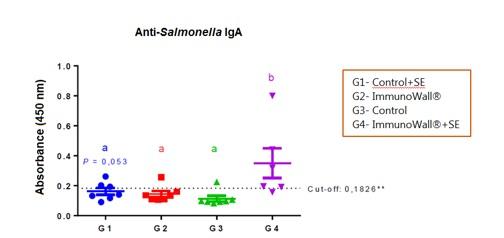The recently Africa swine fever outbreak in China has affected the swine production since the virus is fatal and there is no vaccine to control it. Thousands of animals were sacrificed to avoid transmission of the disease, but the market suffered a strong impact. Thus, the consumption of poultry meat has increased to meet the demand. To supply part of the swine meat market, the poultry production needs to achieve higher production together with meat quality and food safety.
Considering the world wild pressure from consumers, the scientific community and international regulatory agencies, to remove or decrease the use of the antibiotics performance enhancers and the rational use of the therapeutic form in animal production, maintain the production vs. food safety has been a challenge. According to the WHO (2015), about 600 million, or nearly 1 in 10 people worldwide, become ill after consuming contaminated food. Of these, 420,000 people die, including 125,000 children under the age of five. Bacteria caused most cases of foodborne illnesses, and the most frequent serotypes were Salmonella spp, Escherichia coli and Staphylococcus aureus.
The impact of antibiotics on the gut microbiota has been more recently investigated, and researchers have shown that, in addition to altering the composition of the microbiota, antibiotics also can affect the gene expression, protein activity and the overall metabolism of the intestinal microbiota. Microbial changes caused by antibiotics, increase the immediate risk of infection and can also affect basic immunological homeostasis in long-term.
With this new reality, it is imperative that the production chain adapts and applies a strict plan of management, health, and nutrition, since the transmission could be by the ration, environment or even vertical (from the breeder to the chicken/laying hen), so proper management plan is essential in this control.
There are several alternatives on the market to control pathogenic bacteria, such as live attenuated vaccines (which act on Salmonella Gallinarum and Salmonella Typhimurium, also acting on Salmonella Enteritidis). Products that act on the feed as bactericidal antimicrobials, or that act on the animal organism, such as probiotics, organic acids, plant extracts, prebiotics, etc. Each product has a different mode of action, directly or indirectly, modulating the microbiota and the response of the immune system.
The yeast cell wall from Saccharomyces cerevisiae is one of the solutions that can help with the pathogen control program since it is a natural solution that helps to reduce the contamination and prevent the problem. Based on this concept, ImmunoWall® stands out from others products because is composed by a dense yeast cell wall of Saccharomyces cerevisiae with high concentrations of β-Glucans and MOS, resulting in a feed additive with proven results and great cost/benefit.
MOS is known for its capacity to agglutinate pathogens. It will prevent pathogen colonization in the gut as it offers a binding site to harmful bacteria that possess type 1 fimbriae present in the intestinal tract. Because the β-glucans are indigestible, the “trapped” bacteria will be excreted together with the fecal material. It is important to highlight that, to reach its full functionality; the yeast cell walls must have a low digestibility in the intestine. β-glucans are the indigestible portion of the yeast cell wall, thus, the higher the β-glucan concentration, the lower the digestibility of a yeast cell wall.
The β-glucans present will also modulate the immune response of the animals as they are natural stimulants of the innate immune system. When phagocytic cells are in contact with β-glucans, these cells are stimulated, and cytokines are produced. The production of cytokines will trigger a “chain reaction,” inducing a higher immune status in animals, making them able to resist opportunistic infections better. Thus, ImmunoWall® supplementation ensures that birds maintain the balance of the intestinal microbiota and improve immune system responses, resulting in decreased contamination and transmission of pathogenic bacteria to other organs of the body.
A recent study by Beirão et al. (2018), where broilers were given ImmunoWall® (0.5 kg/ton) and infected at 2 days old with Salmonella Enteritidis [SE] (orally at 108 CFU/broiler), showed that at 4 and 8 days old (two and six days after infection, respectively) ImmunoWall® had reduced marker passage (Dextran-FITC, 3-5 kD) to blood in challenged broilers. These results show a significant improvement in intestinal permeability, as SE can stick to the mucosa through its fimbriae, produce toxins and damage tight junctions and enterocytes, invading them and moving to the bloodstream and other organs and tissues (Figure 1).

These results can be explained by the quantification of circulating cells analyzed in the blood withdrew from these broilers. It is important to note that during a normal infection process, blood leukocytes are taken to the gut. However, if the animal has another type of infection, reduced total circulating leukocytes can impair response to the attack to this second antigen/site. This can be especially dangerous when total leukocyte blood levels are very low (leukopenia). In an analysis conducted in the study mentioned above, the group infected and supplemented with ImmunoWall® had reduced blood leukocyte mobilization to the gut at 14 days. However, when this immune system is subdivided, and different cells are analyzed, animals in this group have more APCs, suppressor monocytes (that prevent an uncontrolled immune response) and helper T lymphocytes (CD4 - they produce interleukins and stimulate the multiplication of cells that will attack the antigen) compared to the group of untreated challenged animals. The group of unchallenged animals given ImmunoWall® showed intermediate responses (between the challenged and the unchallenged control) to the analyzed cells mentioned above, in addition to cytotoxic T lymphocytes (CD8), which are important to prevent or control Salmonella invasion, as they can invade monocytes and then move to the liver and other organs.
The graph t 1 below shows that supplementation with ImmunoWall® resulted in higher production of anti-Salmonella IgA at 14 days old. This indicates that the immune system had a quicker and stronger specific response, using less energy and nutrients, as the inflammatory response seemed to be shorter.
Graph 1. Relative IgA quantification in reagent serum against bacterial LPS. The cut-off line is shown. Different letters on each group indicate statistical relevance. ANOVA test with Tukey post-test (P<0.05, except when otherwise indicated).
SE can be a problem to broilers that still do not have a mature immune system, as they cannot fully control the infection. For this reason, most of the improved responses found in this study were observed up to day 14. Therefore, β-glucan supplementation can help broilers activate the immune system and have an early and quicker innate immune system response, reducing/minimizing the damages caused by pathogens and, consequently, performance impairment. This type of response is especially important in animals at early development stages, during reproduction, periods of stress and environmental challenges; acting as a prophylactic agent and increasing animal resistance, thus minimizing losses.
Several other studies have confirmed the efficacy of ImmunoWall® in reducing pathogen contamination in broilers and eggs (Hofacre et al., 2017; Ferreira et al., 2014), reducing mortality and improving productivity (Bonato et al., 2016; Rivera et al., 2018; Koiyama, et al. 2018), especially under challenge. There are no feed additives that can solve problems related to management, health plan, immunization, nutrition, water quality, among others. Additives are tools used to help control and prevent them. Intensive animal production is known to be extremely challenging. Therefore, strengthening the immune system can be one of the keys to higher productivity.
A link between quality, nutritional value, and food safety is a task that has required a lot of research by the industries to ensure public health. And while intensive poultry production is a challenging environment, food security begins on the farm, where it is possible to control pathogens without the use of antibiotics as growth promoters. However, it is of the utmost importance that producers, who are the first link in the chain of production, commit themselves, as it is proven that the reduction of pathogens in the field contributes significantly to reducing the risk of foodborne diseases due to bacterial contamination.












.jpg&w=3840&q=75)